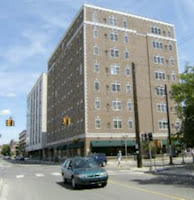FINAL VOTE JANUARY 20, 2008
The city has proposed an ordinance that would fine any one with graffiti on their property if it was not removed within two days of receiving a notice from the city. The fines are $100 for a first offense. The maximum fine is $500, but each day the graffiti remains is considered a separate offense.
This is a bad ordinance for several reasons. The first is that it further penalizes the victim of a crime. The property owner is fined for possession of something they did not intentionally acquire, probably do not want, and cannot remove without expense. Other cities that wish to track the graffiti have fines for failing to report it. As one member of an Erie Pennsylvania graffiti task force stated: "You want to make sure you're not making a victim out of the property owner."
I discussed the ordinance with one commercial building owner that had some graffiti on his building. He said he would be very happy to remove it if someone told him any easy way. He said he had tried numerous solvents but the building was porous brick. He did not think it was possible to remove without sand blasting the entire side of the building which would be expensive and degrade the brick surface.
Council member Sandi Smith, the only Council member that voted against the ordinance on first reading, said it very clearly; “I don't want people to have to choose between graffiti removal and making payroll” ( http://annarborchronicle.com/2008/12/15/germantown-study-it-or-not/ )
A second reason to oppose this ordinance is that it significantly reduces the rights of property owners and transfers control to the city government. Suppose someone paints the word 'peace' or an artistic peace sign on your building or garage. Maybe you like it and would like to leave it. Under this ordinance you do not have that right. If you refuse to remove it the city can clean or paint your wall and bill you for the cost. Why is this different than the original graffiti? Both are painting or modifying your property without your permission. The only real difference is the city bills you for the cost. If you don't pay it, the cost is added to your tax assessment. If you don't pay the taxes the government takes the property.
The previous hypothetical example has occurred in other cities. Ypsilanti has an ordinance similar to the proposed Ann Arbor ordinance. A person in Ypsi thinks the graffiti on his building is artistic and wants to keep it. The government says no; you do not have the right to decide the art on your building. This seems like a violation of free speech. (http://www.mlive.com/news/index.ssf/2008/01/business_owner_sees_it_as_art.html )
A third reason to oppose the ordinance is that it diverts city resources from more serious crimes. One of the reasons often cited for an ordinance of this type is that graffiti and more serious crime are correlated, so if we stamp out graffiti this will reduce serious crime. The first part is true. Economically distressed areas usually have more graffiti and more crime. The second part, removing graffiti will reduce serious crime, is often cited in popular literature but rarely supported in more rigorous studies. New York city spent $500 million eliminating graffiti from the subway trains without reducing serious subway crime. This is discussed further in the following post, Graffiti and Crime
If this weren't so expensive and an attack on free speech it would be comical. Possession of marijuana, $25 fine; possession of graffiti $100 to $500 plus removal costs. The Ann Arbor Library has an annual Teenage Graffiti Art Contest. Are we spending tax money to give the kids practice on paper before they graduate to buildings? The library proudly displays the graffiti art, but if it is on your property you get busted. The City spends a large amount of tax money for art in public places. Some of the graffiti is better than the commissioned art (most is not) but one we pay for and the other we pay to remove.
The final vote on the ordinance will be Tuesday, Jan 20, 2008 unless delayed. There will be a public hearing at this Council meeting. I encourage everyone to come and speak your opinion on the ordinance. If this is inconvenient email your Council member. The single link to email the Mayor and all Council members is at the bottom of the page.
 Are you curious about the secret email messages that Ann Arbor City Council members send to each other during public Council meetings in which all communications are supposed to be open to the public? Now you can read what they say in private when they should have been listening to public comments and their colleagues conducting council business. These City Council e-mails were obtained by the Freedom of Information Act. Read secret e-mails passed around during council meetings. (Note: the two emails relating to the parking structure were not sent during a public meeting.) For more immaturity and disdain for process see email from Sept and Oct 08 and Sept - Dec 08 e-mails and an article in The Ann Arbor Chronicle.
Are you curious about the secret email messages that Ann Arbor City Council members send to each other during public Council meetings in which all communications are supposed to be open to the public? Now you can read what they say in private when they should have been listening to public comments and their colleagues conducting council business. These City Council e-mails were obtained by the Freedom of Information Act. Read secret e-mails passed around during council meetings. (Note: the two emails relating to the parking structure were not sent during a public meeting.) For more immaturity and disdain for process see email from Sept and Oct 08 and Sept - Dec 08 e-mails and an article in The Ann Arbor Chronicle.
